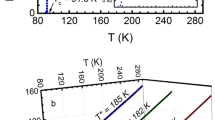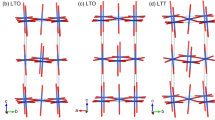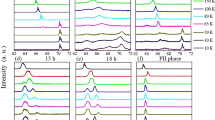Abstract
Several of the theories proposed to account for the unusually high critical temperature (Tc ) of YBa2Cu3O6.9 rely on a reduced dimensionality of this system: the stronger electron–phonon coupling in lower-dimensional systems of marginal stability may allow high-Tc superconductivity by the conventional phonon-mediated mechanism1. X-ray powder diffraction experiments have shown the structure to consist of a tripled perovskite unit cell2 which, in the presence of nine oxygen atoms, is three-dimensionally connected. The theoretical proposals therefore depend crucially on the details of the atomic arrangement to reduce the dimensionality of the system. Recent X-ray work on small single-crystal grains3,4 has established the structure of the metal framework in this system, but disagreements persist regarding the disposition of the oxygen vacancies needed to achieve the experimentally observed stoichiometry. Moreover, no conclusive information is available regarding the presence of long-range order in the arrangement of the oxygen vacancies, which could give rise to further reduced-dimensional features in this system5,6. Here we report the results of a high-resolution transmission electron microscope study of YBa2Cu3O6.9, which elucidates the microstructure of this system on an atomic scale. Our results can be consistently interpreted in terms of a particular form of long-range order in the disposition of the oxygen vacancies. We also observe twins, and planar defects that can be modelled as extrinsic faults. These defects reduce the O/Cu ratio of the material from 2.33 (for the inferred unit cell) towards the experimentally observed value of 2.3 (ref. 2).
This is a preview of subscription content, access via your institution
Access options
Subscribe to this journal
Receive 51 print issues and online access
$199.00 per year
only $3.90 per issue
Buy this article
- Purchase on Springer Link
- Instant access to full article PDF
Prices may be subject to local taxes which are calculated during checkout
Similar content being viewed by others
References
1. Bardeen, J., Cooper, L. N. & Schrieffer, J. R. Phys. Rev. 106, 62 (1957). 2. Cava, R. J. et al. Phys. Rev. Lett. 58, 1676–1679 (1987). 3. Siegrist, T., Sunshine, S., Murphy, D. W., Cava, R. J. & Zahurak, S. M. Phys. Rev. B (in the press). 4. Angle, R. et al. Eos 68, 161 (1987). 5. Mattheiss, L. F. & Hamann, D. R. Solid St. Commun. (submitted). 6. Yu, J., Freeman, A. J. & Xu, J. H. Phys. Rev. Lett. 58, 1035–1037 (1987). 7. Spence, J. C. H. & Tafto, J. /. Microsc. 130, 147–154 (1983). 8. Goodman, P. & Moodie, A. Acta crystallogr. A30, 280–290 (1974). 9. Beyers, R. et al. Appl. Phys. Lett, (submitted). 10. Chen, C. H., Werder, D. J., Kwo, J. R., Liou, S. H. & Hong, M. Phys. Rev. B (in the press). 11. Anstis, G. R., Lynch, D. F., Moodie, A. F. & O'Keefe, M. A. Acta crystallogr. A29, 138–147 (1973). 12. Nobel Symposium Chem. Scripta 14 (1978–79).
Author information
Authors and Affiliations
Rights and permissions
About this article
Cite this article
Ourmazd, A., Rentschler, J., Spence, J. et al. Microstructure, oxygen ordering and planar defects in the high-Tc superconductor YBa2Cu3O6.9. Nature 327, 308–310 (1987). https://doi.org/10.1038/327308a0
Received:
Accepted:
Issue Date:
DOI: https://doi.org/10.1038/327308a0
This article is cited by
-
Vacancy ordering and lithium insertion in III2VI3 nanowires
Nano Research (2009)
-
Local cation non-stoichiometry in Y1Ba2Cu3O7−z from citrate combustion and conventional routes
Bulletin of Materials Science (1991)
-
A study of the properties of the YBa2Cu3O7−δ high temperature superconductor
Journal of Materials Science (1989)
-
Partial oxidation of methane over Y1Ba2Cu3O6+X?ZFZ
Catalysis Letters (1989)
-
Chemically sensitive structure-imaging with a scanning transmission electron microscope
Nature (1988)
Comments
By submitting a comment you agree to abide by our Terms and Community Guidelines. If you find something abusive or that does not comply with our terms or guidelines please flag it as inappropriate.



